What are the Basic Motorcycle Hand Signals Every Rider Should Know?
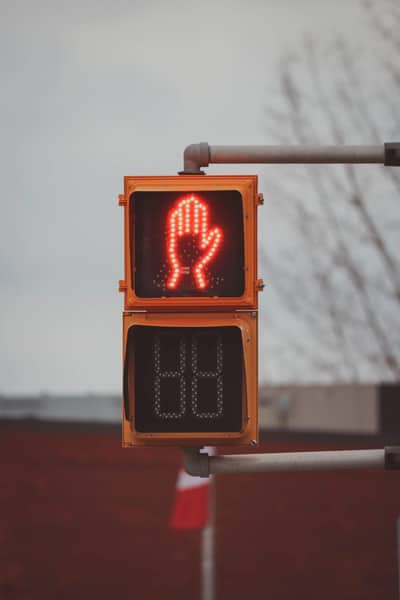
Effective communication with other riders is crucial, and this is where motorcycle hand signals come into play. This blog post explores the nitty-gritty of motorcycle hand signals, their significance, and the multiple types of signals typically used in many scenarios by experienced and novice riders throughout the world. Our purpose is to give you the awareness required to communicate effectively with other bikers on the road, advancing safety and preventing accidents. By adopting these signals, you can ride with confidence, secure in the knowledge that you’re contributing to safety and communication on the road.
Why Do Motorcyclist Use Hand Signals
Using motorcycle hand signals is an invaluable tool for motorcycle riders due to their ability to effectively communicate between each other while riding. This is especially true in situations where verbal communication is not feasible, such as when riding in groups or when the motorcycle’s lights are not visible or working. Furthermore, it is important to understand the different hand signals, as motorcycles may vary in their turn signal systems. As a result, being knowledgeable in the use of hand signals is essential for any motorcyclist; it not only helps to ensure safety, but also maximizes the overall riding experience.
Common Motorcycle Hand Signals

Following are the demonstration of how to hand signal on a motorcycle, please read throughly and use the image provided to get a clear understanding. one of the main and simple motorcycle hand signals greeting is the nod. If you are a motorcycle rider you know everytime you come across another rider you do the nod to say “Hello”.
Turn Left
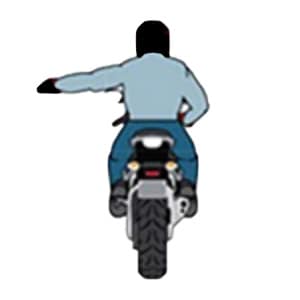
Extend your left arm in a straight line with your fingers facing up to execute the left turn signal. This tells other riders or drivers that you plan on turning left at an upcoming junction or changing lanes to the left.
Make sure you keep the signal steady until the turn is complete, giving others enough time to react appropriately. This is especially crucial when riding in groups, where other riders may not be able to see the motorcycle’s signal or may be too close to view it.
Turn Right
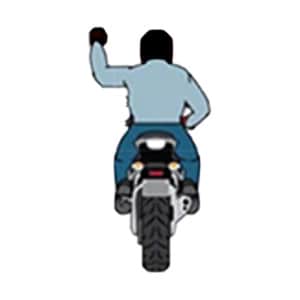
To use this signal, you should raise your left arm, bending it at the elbow, with your forearm at a 90 degree angle and your fingers pointing upwards. This informs other riders or drivers that you intend to turn right at the upcoming intersection or switch lanes in that direction.
It is essential to hold this signal stable until the turn is finished so that other people have enough time to act accordingly. Furthermore, this signal helps reduce the risk of collisions since it is not always possible for others to see the motorcycle’s turn signal.
Stop
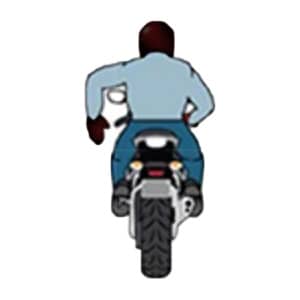
To communicate that you are about to stop your motorcycle, extend your left arm out straight with your palm down facing the road. This is especially critical in instances when your motorcycle’s brake lights cannot be seen, such as when in a group, as it gives other riders or drivers the chance to respond in time.
It is important to keep your arm steady until the motorcycle has come to a full stop. Remember that the stop signal should not be employed to slow down or signal a turn, only to stop the motorcycle entirely.
Speed Up
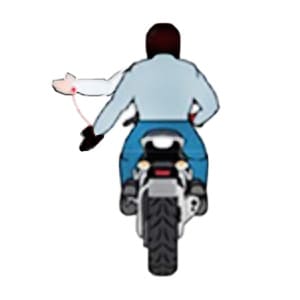
To execute this signal, extend your left arm and point your index finger up. Then, do a circular movement with your finger.
This is a great way to let other riders know that you are ready to pick up the pace without having to verbally communicate, which can be difficult with the wind and noise on the road. The speed up signal is especially useful when riding in a group since different motorcyclists may have different skill levels or motorcycles with different capabilities.
Follow
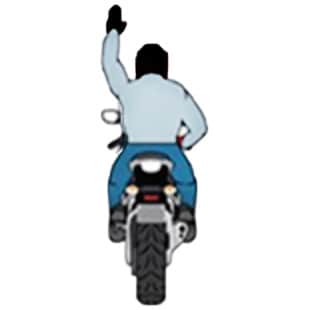
For the Follow signal, the rider extends their left arm out to the side with the palm facing downward and the index finger pointed upward.
This is an important tool for motorcycle riders to ensure safety on the road, especially when riding as part of a group. Regularly practicing hand signals and being aware of their meaning is key to effectively communicating with other riders and preventing accidents.
Cops Ahead
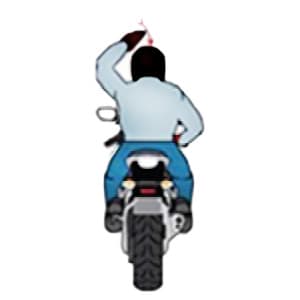
In order to notify the other riders in a group of the presence of law enforcement on the road, motorcycle riders use the “cops ahead” hand signal.
The lead rider in the group extends their left arm outwards with the palm facing downwards and then repeatedly points the index finger to the ground, acting as a warning to the riders to be careful as they advance. It is essential to only use this signal when police officers are actually present, as any misuse can lead to chaotic and potentially hazardous outcomes.
Fuel

Riding in a group can be complicated if riders have different fuel ranges and require stops, which can lead to delays and confusion.
To perform the fuel signal, the rider places their left hand on their gas tank and taps it a few times with an open palm. This gesture communicates to other riders that they need to stop for fuel soon. This signal can also be modified to indicate the urgency of the fuel stop by tapping the tank more rapidly or repeatedly.
For more information check out the following video -
Tips for Using Basic Motorcycle Hand Signals
Here are some tips to help you utilize them effectively:
- Have a routine: Practicing hand signals on a regular basis will help you communicate with other riders with confidence and proficiency.
- Make sure they’re visible: Make sure your hand signals are visible and easily recognizable. Use exaggerated gestures and check that they are visible in the rearview mirrors of other riders.
- Stick to the rules of the road: Hand signals should supplement, not substitute, the customary traffic signals and signs. Always abide by the rules of the road and use hand signals to pass on additional information to other riders.
- Utilize the same motorcycle hand signals consistently: Make certain all riders in the group comprehend and use the same hand signals in a consistent manner to avoid misunderstandings and guarantee successful communication.
- Plan ahead: Use hand signals to indicate any changes in speed or direction in advance, giving other riders enough time to react and adjust accordingly.
- Respect other road users: Hand signals are not just for other riders but also for other road users. Use hand signals to communicate with pedestrians, cyclists, and drivers on the road.
Common Mistakes to Avoid
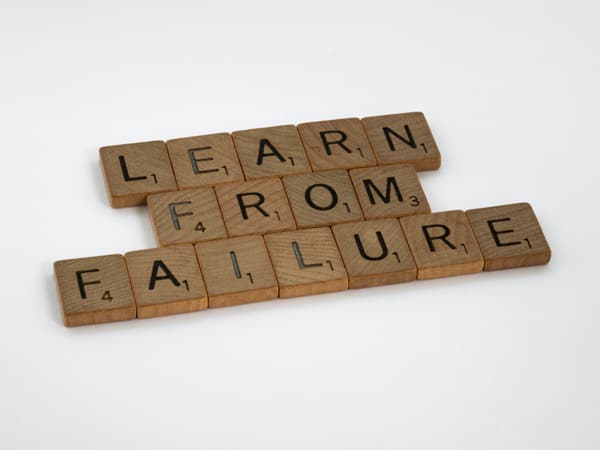
If riders fail to use hand signals with uniformity, or use them incorrectly, it can result in miscommunication and potentially hazardous situations. It is important to utilize motorcycle hand signals to communicate with all members of the riding group, not just those behind the rider. Motorcycle Hand signals should be used to complement appropriate riding techniques such as utilizing turn signals and proper lane positioning.
- Not using motorcycle hand signals consistently: Using different hand signals for the same meaning or failing to use hand signals consistently can lead to confusion and miscommunication among riders.
- Using motorcycle hand signals incorrectly: Incorrect use of hand signals, such as using the wrong signal for a given situation or using the signal inappropriately, can lead to misunderstandings and potentially dangerous situations.
- Failing to communicate with all riders: Hand signals are meant to communicate with all riders in a group, not just those directly behind you. Failing to communicate with all riders can lead to confusion and potentially dangerous situations.
- Using motorcycle hand signals as a substitute for proper riding techniques: Hand signals should be used to supplement proper riding techniques, such as signaling turns with the bike’s turn signals and using proper lane positioning.
In conclusion, motorcycle hand signals are a critical part of safe riding. Whether riding alone or in a group, knowing how to communicate effectively with hand signals can help you avoid accidents and stay safe on the road. It’s important to practice these signals regularly and to use them consistently every time you ride.
Frequently Asked Questions
Join Our Riding Community
Get exclusive gear reviews, riding tips, and early access to deals delivered to your inbox.
No spam. Unsubscribe anytime. We respect your privacy.